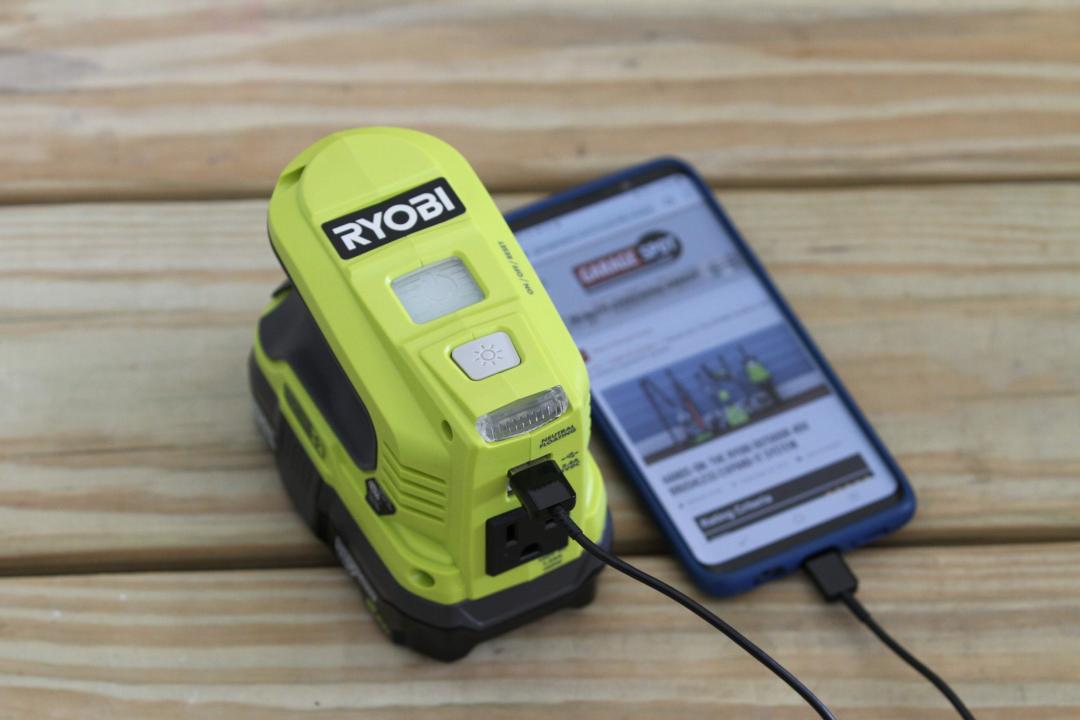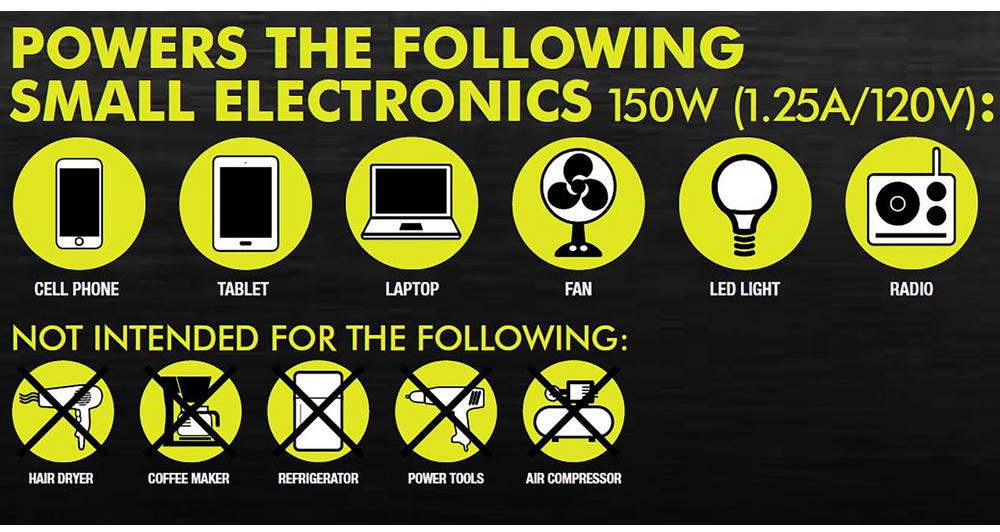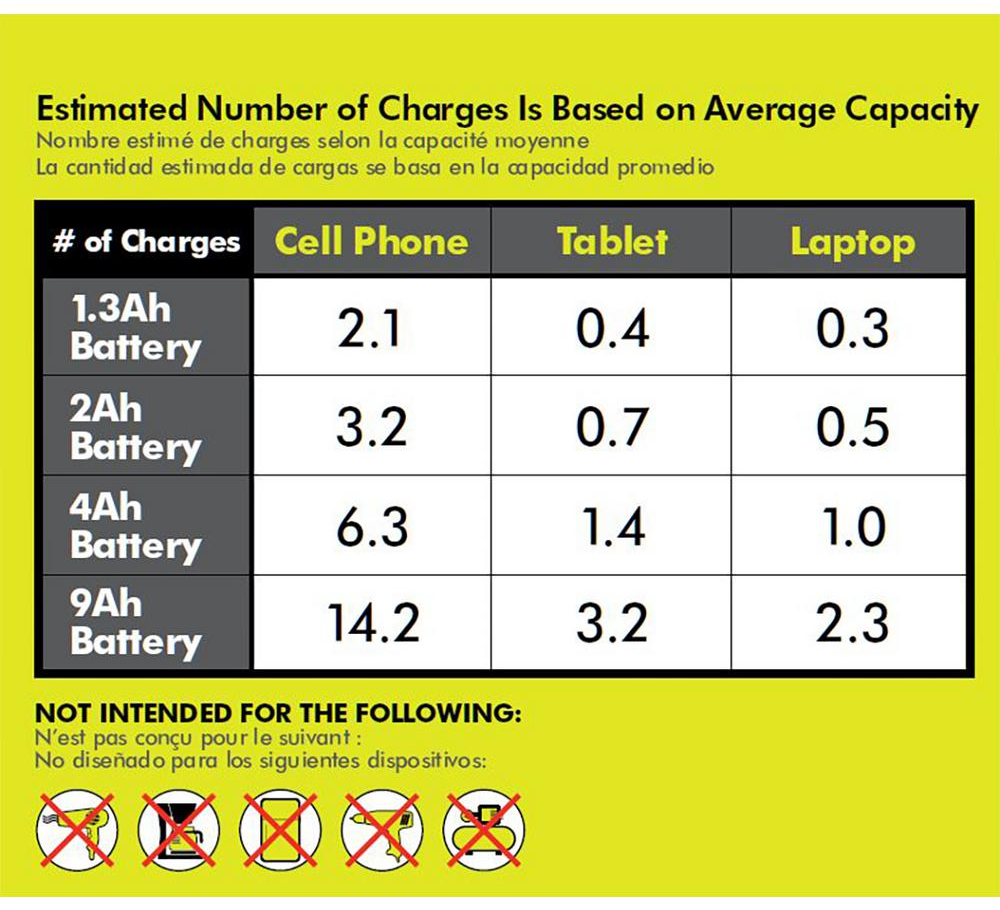While it’s slowly coming to a close, here in Florida, it’s both hurricane and outdoors season—camping, hiking, and beach-going. In the old days (read: “back in my day” in your best old-man voice), we got by on a pack of ‘C’ batteries when the power went out or we were out on the trail and needed some light. Today, however, it’s almost impossible for us to “unplug” and be without our devices, so portable power generator is a must for many. Lucky for us, battery tech and innovation have grown exponentially.
The new [amazon link=”B07TGJ7WWQ” title=”RYOBI PowerSource 18V 150-Watt Power Inverter & Generator” /] is one such innovation. Equipped with two USB and a single 120-Volt wall outlet, this little 3¼- x 5¼-ish inch powerhouse accepts any RYOBI One+18V battery to power most laptops, tablets, smartphones, and other small electronics for one to several hours. More on that in a sec.
[amazon fields=”B07TGJ7WWQ” value=”thumb” image_size=”large”]
[amazon fields=”B07TGJ7WWQ” value=”button”]
Table of Contents
Design & Build
Sporting the recognizable RYOBI green housing and gray rubberized grip, the RYOBI One+ PowerSource inverter/power brick (they call it a “generator”) features two USB ports, a 120-Watt standard U.S.-style wall outlet, an integrated LED light, and overload and short-circuit protection. Without a battery in it, the unit only weighs about a pound. And while it doesn’t feel cheap, it definitely feels far more substantial once a battery is plugged in, which is the only way it’ll work anyway.
The large on/off button on top of the inverter will illuminate green when there’s adequate power and red when power is low. The integrated LED light is OK but not great—it’s good for quickly finding something or creating some ambient lighting. If it were pitch black and you were trying to plug something into the outlets, the LED isn’t in the best place, as it’ll blind you trying to see the plugs. We would also like to be able to turn the light on with a long press (and therefore power-up the unit) but you have to turn the power on first, then the LED. Minor but of note to us. Without looking, we also mistook the LED button for the power button more than a few times, as they’re right next to one another. We’re not all that bright though. Pun intended.
Another minor point for us is that the 2018 HP laptop we were testing this inverter with has a larger-than-average plug. With that plugged into the 120V outlet, we couldn’t fit a USB plug on the bottom of the two USB plugs. An extension cord would’ve solved this but we thought it was worth pointing out.
After about 15 minutes of powering our laptop and cell phone (more on that below), the RYOBI PowerSource fan kicked in. It’s a bit loud, but not much louder than a computer fan if that computer was working pretty hard. The fan doesn’t seem to be a variable speed fan either—it was all or nothing. That said, it only came on once every 15 minutes or so, and the unit itself was only very slightly warm on top.
When the juice ran out, there was no warning. The green power LED did turn red but only for a moment before the unit shut down. Some kind of subtle beep would’ve been nice so you can save your work, finish your game or if you’re working on something where light is critical and it’s being powered by this tool, you have a minute or two to prepare before instant darkness.
Performance
It’s basically impossible to say how long your devices will last running off of the RYOBI PowerSource because there are just too many variables, mostly based around power draw. There’s some math there, but that’s beyond our pay scale. RYOBI provides a couple of small charts in the box and on its website to set expectations on what the unit is capable of. You can see those below. You’ll note that they aren’t calculating runtimes, but rather the number of charges per typical device, which is fine.
As noted above, any RYOBI One+ Lithium-Ion battery will work with the RYOBI One+ PowerSource and, depending on what you’re powering, the tool will certainly last longer when the unit is combined with larger Ah batteries. For this review, we only had a 2.0Ah battery, which is RYOBI’s third smallest, after the 1.3Ah and 1.5Ah compacts. RYOBI also has several other battery options available, from 3.0Ah to 9.0Ah and in between. Just know that batteries for this and just about any brand cordless tool are quite expensive, with the RYOBI One+ 9.0 Ah 18V battery running at around $140 at the time of this review.
On our fully-charged 2.0Ah battery, we were able to charge our Samsung S9+ smartphone from about 45% to 100% while simultaneously streaming video on it and on an iPad (which was already charged), and surf the Web on a small HP laptop with very few background processes for about 40 minutes before the red light appeared.
Value
The RYOBI PowerSource 18V 150-Watt Power Inverter & Generator is a great value if you’ve already bought into the RYOBI 18v line of tools. If you haven’t, then you’ll need a battery or three and a charger, which can add up pretty quickly to several hundred dollars, depending on which batteries you go with.
Overall, this is a great little device to keep in your outdoor adventure pack or hurricane preparedness kit—just be sure to also have at least one fully-charged battery to go with it!
[amazon box=”B07TGJ7WWQ”]Rating Criteria
Design
Build Quality
Performance
Features
Value
Overall Rating
Very useful to have around the campsite or during a power outage at home. If you're not already invested in the RYOBI 18V line of tools, however, the cost of this and at least one battery and charger means there are more affordable options.












